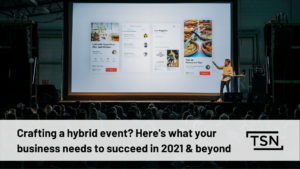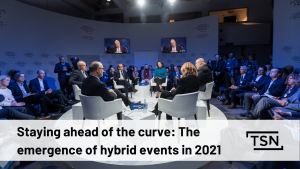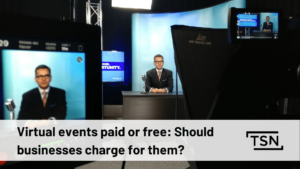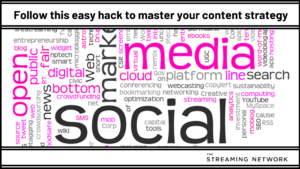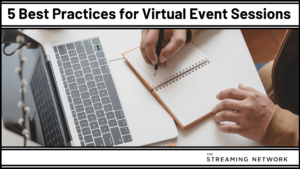Today’s question is, are you producing engaging webinars, and if so, how are you tracking your event engagement?
You have between 30-55 minutes of a webinar attendee’s attention. This is before they decide to check their social media and become distracted by anything else which ultimately leads them to leave your event.
How do you avoid this from happening?
First, let’s take a look at the most typical features that people use to engage in webinars:
- Content filled slide decks – stuffing as much information as possible into your PowerPoint (check out our blog to learn how to avoid writing too much information in your slide deck).
- Doing your Q&A at the end of your webinar – asking for webinar feedback or questions related to your event.
- Leveraging feedback surveys in order to gain insights about your audience
This is a good start – but it is not the best way to keep your webinar attendees engaged.
You are drawing attendees to your event because you promised them a solution to their current obstacles. If they are not interacting with you throughout your event, you will lose them.
Think about the last time you may have attended a lecture. There was always one speaker who never asked the audience if they had any questions for the entirety of the lecture. How much do you recall from that lesson? Probably not a lot. You most likely got distracted by something else.
What’s the solution to this dilemma?
Create A Poll Or Offer A Resource
Plan to have a couple of engagement points throughout your webinar. Think of them as transition markers between points to help your webinar flow better.
Asking a question right off the bat or within the first 10 minutes of your webinar may not result in the best response. Usually, people are hesitant to be the first to reply in a new setting.
So break the ice with a poll.
Let’s say that you are delivering a webinar that showcases your product or service as a solution to the problems your attendees are facing.
Open with a poll by asking what are the main obstacles your attendees face in their day-to-day lives. If you have consulted with your sales team or have done proper research into your attendees, you should have a list of common roadblocks that they face.
This is something that they can relate to and shows that you understand some of the challenges they experience. It is easier to click a pre-selected option rather than write out an answer to an open-ended question near the beginning of a webinar.
Similarly, you can use polls to qualify leads. This will give you an idea of which leads can quickly become SQLs.
Ask your audience, “Are you planning to purchase X (your service) sometime soon?” Yes | No | Not Sure | Just browsing at the moment.
Any leads that select the Yes option should gain a higher lead score and be prepared to enter the sales funnel shortly after the webinar concludes.
Moving along to resource downloads.
Everyone loves free stuff – so give your attendees something special as a way of thanking them for their attendance.
If you are creating a webinar based off of a lead magnet, offer it to your attendees during the event. Track how people download your asset, this will help with segmenting and nurturing leads.
Offering a resource further establishes yourself as a Thought Leader by providing valuable content through engaging webinars.
Post-Webinar Communication
One of our favourite webinar best practises is the follow-up email.
But follow-up emails are not the only communication method you can leverage with your leads.
Near the end of your webinar, throw in your LinkedIn contact information for anyone to reach out to you personally. This shows that you are willing to start a conversation directly with your webinar attendees.
It is also a great way to kickstart a potential sales relationship down the road.
There will be webinar attendees who may be in leadership positions themselves – people who make decisions for their teams.
Building relationships with these decision-makers early on can make the difference between an MQL and an SQL.
Leveraging Feedback Surveys
Feedback surveys are a great webinar tool if you can gain insights on your audience.
Keyword here is, if.
Most often than not, your audience will feel incentivized to fill out a survey if they either had an amazing webinar experience or if something was not working for them. These are attendees on two opposite ends of the spectrum – you will most likely miss everyone else in the middle.
It can be difficult to leverage an effective feedback tool, so one tactic we at The Streaming Network leverage is to repurpose polls.
Think about the 5 main things you want to know about your audience.
- What type of webinars would they be interested in watching in the near future?
- Did they find this event to be helpful?
- What day and/or time works best for them to watch your next webinar?
- Why did your attendee decide to come to your webinar?
- Are they likely to watch another webinar by you (if not, why)?
These are just a few examples of some of the information you should be gathering from your audience in order to create more engaging webinars.
When the speakers are nearing the end of their webinar, use the poll function to ask those 5 important questions. Keep it short and simple.
You may not get the holistic data you were aiming for, but you will find some helpful insights about your webinar attendees that can help prepare you for your next webinar event.
Let’s Recap
With a small window of opportunity, about 30-55 minutes to be accurate, you have one chance to leave a big impression on your webinar attendees. In which case, you need to be sure that you are producing highly engaging webinars.
This can be accomplished by creating polls throughout your webinar event. They can also act as transition periods to help your webinar topics flow from one point to the next.
Polls also are a simple tool that can net you a lot of information about your leads.
Offering free lead magnets that are related to your webinar topic is another great way to keep your audience engaged and simultaneously establishes you as a Thought Leader.
Give your audience a chance to communicate directly with you, or whomever your speakers are, by adding in your LinkedIn contact details. It is a great way to start a (potential sales) relationship with someone interested in your content and service.
Someone who might be the decision-maker at their company.
Finally, use polls to get feedback from your webinar attendees.
Keep them simple and short so your attendees don’t leave due to boredom. Ask 5 questions that will help you determine who needs more nurturing as an MQL and who can be qualified to meet with sales.
Here are just a few tips on how to create more engaging webinars. For a full list of strategies, download our Webinar Engagement eBook.


